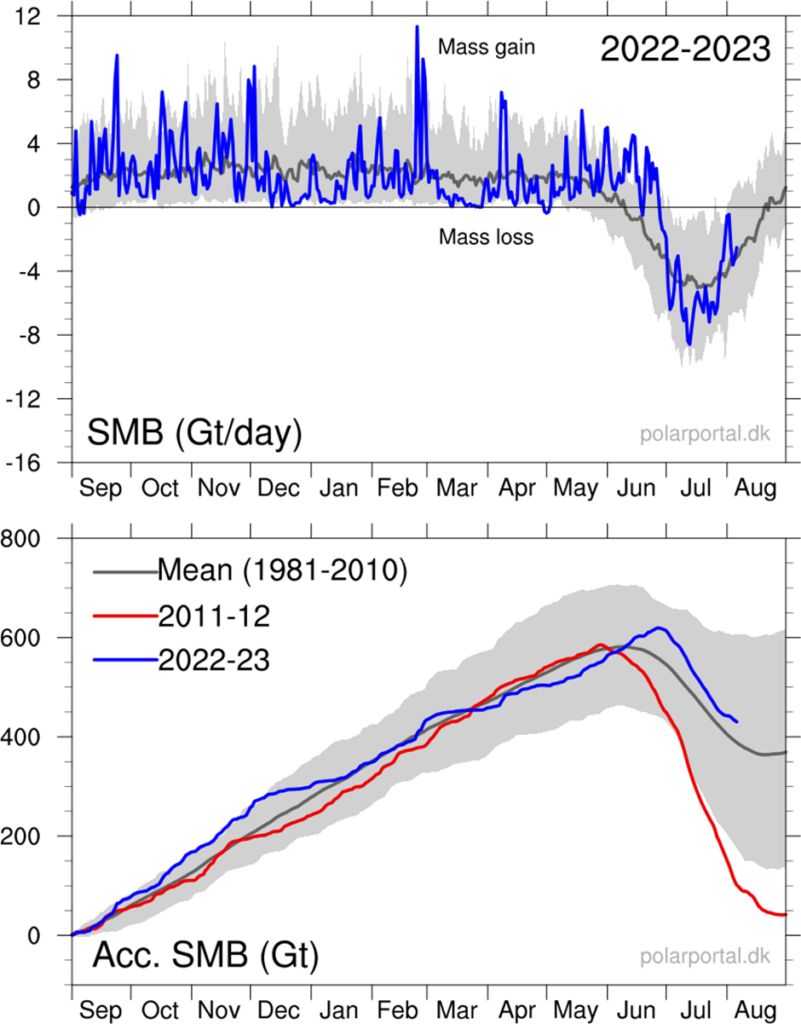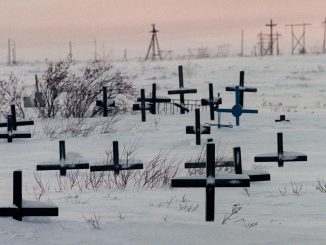
Original Article by Daily Sceptic
The new era of ‘global boiling’ has brought a return of the much loved climate scare story featuring the imminent demise of the Greenland ice sheet. The Daily Mail recently ran a headline noting the ‘Impact of Global Boiling‘, saying it has “shocking” photos showing how much the ice sheet has melted during the “hottest month ever recorded on Earth”. Snow melt is said to be higher than the 1981-2010 average. It’s nothing but a flagrant deceptive lie!
But, those who strive for accuracy in these matters are likely to quibble. The Earth is not “boiling” – that is the unhinged raving of the UN Secretary-General Antonio Guterres – the claim about July comes from a computer model, while “ever” refers to data of varying quality going back barely 150 years. Furthermore, the surface balance of ice on the Greenland ice sheet is higher than the 1981-2010 average, and could improve on last’s year performance, when there was little or no loss of the surface mass after the brief summer melting season.

If the Mail is “shocked” by how much the Greenland ice sheet has melted this year, it probably didn’t consult the polar portal site run by Danish meteorologists, which updates an accurate record on a daily basis. Both graphs above show the effect of a cold June where the ice loss was considerably lower than the previous year. Warmer weather arrived from the south in late June in time for the peak summer melt season.
As the second graph shows, the accumulation of surface ice on Greenland is more than the 1981-2010 average, and a big improvement on a decade ago. But as the Daily Sceptic noted recently, the current improvement can be seen in an even better light. A number of scientific institutions still use a decadal 1981-2010 average for comparison purposes, despite data to 2020 being available. The cynical might note that the ice sheet lost just 51 gigatonnes a year in the 1980s, compared to an annual loss of 244 gts in the 2010s. Updating the average figure would greatly amplify the recent, and continuing, recovery in the surface ice mass.
The ”shocking” before and after photos revealing how snow melts in the summer, even in Greenland, were taken by NASA satellites over the Frederikshab Glacier running down to the warmer south-west coast. The information and photos came from a NASA blog aimed at educators headed ‘Wasting Away (Again) in Greenland‘. More than halfway through the 2023 melting season, reports NASA, “Greenland has seen a substantial transformation of its snow cover”. This line – if it’s summer in Greenland, the snow melts – is readily taken up by the Mail. “According to scientists, snow falls on the Greenland ice sheet every winter… but experts say hotter summer temperatures are reducing the amount of snow cover.” The NASA blog is heavily quoted: “More than halfway through the 2023 melting season, Greenland has seen a substantial transformation of its snow cover. … Changes are the result of the increasing warmth of summer weather that took hold across the region in late June.”
Hold the front page – snow melts during the summer in Greenland, not many dead.
It is not difficult to find areas of rock in Greenland, especially in the south-west where most of the population of 55,000 live. The climate in this area is characterized as ‘low Arctic’ and temperatures are well above freezing in the warmest months. Ice in the Arctic waxes and wanes on a cyclical basis, while the long-term Greenland temperature is fairly stable. At a time when the planet has seen a gentle period of warming over the last 100 years, Greenland even held back slightly on the general trend. The five-year moving average of -18.57°C in 1929 compares with a measurement in 2021 of –17.96°C. The largest boost, as with other areas of the world, occurred in a short period in the 1980s and 90s, as the World Bank graph below shows. Since that time, as elsewhere, the rate of warming has considerably declined.

The Greenland ice sheet is the alarmist scare story that keeps on giving because water flowing off the land can increase sea levels. The Mail notes that scientists have already warned this year that the Greenland ice sheet is the “hottest it has ever been” and will cause global sea levels to rise by 20 inches by 2100 if it keeps warming at the same pace.
In fact this information is linked to an earlier article that referenced a science paper quoting temperatures between 2000-2011. The next paragraph of the current story reports a rise of four feet or 1.2 metres by 2300, “even if we meet the 2015 Paris climate goals, scientists have warned”. Scientists might “warn”, but all these opinions of greatly increased sea level rises are produced by climate models, often assuming outlandish future scenarios.
Again, sea level rises are notoriously difficult to calculate since land rises as huge weights are lifted from it. Many areas in the northern hemisphere show falls in coastal sea levels, and this process is ongoing since the Earth is currently in an interglacial phase. In fact, current rises of 2mm a year are tiny compared with the huge boosts between 12,000 to 4,000 years ago.
Again, hold that front page – shock 2mm annual rise will lead to civilization being inundated in the next century by a catastrophic seven inch increase in sea levels. Not many expected to die.




